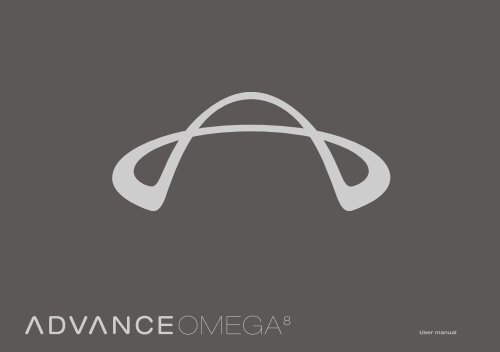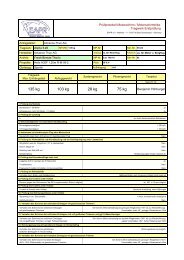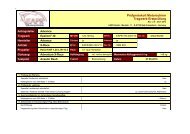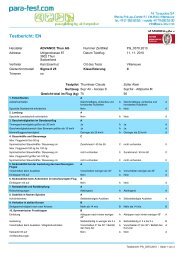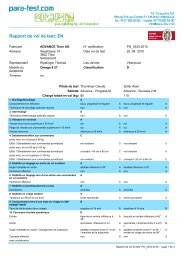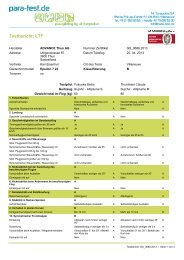Advance OMEGA 8 User Manual
Advance OMEGA 8 User Manual
Advance OMEGA 8 User Manual
- No tags were found...
You also want an ePaper? Increase the reach of your titles
YUMPU automatically turns print PDFs into web optimized ePapers that Google loves.
Thank you for flying ADVANCECongratulations on your choice of an <strong>OMEGA</strong> 8 - a quality productfrom ADVANCE. We are sure that you will spend many rewardinghours in the air with it.The user manual is an important part of the glider. Here you will findinstructions and important information about safety, care of the gliderand maintenance, and that’s why we recommend that you read thisbooklet carefully before your first flight.The latest version of this manual as well as further updated informationcan be found at www.advance.ch. Any new safety-related informationwill also be published on the website. If you have any furtherquestions or problems please contact your dealer or get in touch directlywith ADVANCE.We wish you a lot of enjoyment from your <strong>OMEGA</strong> 8, and always«happy landings».Team ADVANCE4
About ADVANCEADVANCE, based in Switzerland, is one of the world’s leading paraglidermanufacturers. Since it was founded in 1988, the companyhas consistently pursued its own directions and concepts, both indevelopment and production. The results are quality products withdistinctive characteristics.ADVANCE attaches great importance to after-sales customer support,and has built up a worldwide service network for this purpose.An on-going interaction with its customers brings in a steady flow ofnew knowledge that finds its way into ADVANCE products, thus completingthe «Circle of Service».At the heart of the ADVANCE brand is a team of specialists whoshare the passion of the customers who place their trust in the company’sproducts. With their thorough understanding of flying theycontribute their valuable personal experience and dedication to theworking processes.For many years ADVANCE has drawn on the competition scene forits technical expertise. Its small team of test and competition pilotsregularly notches up remarkable sporting successes with ADVANCEprototypes, winning numerous important international titles.Total control of the production process and supervision of the workingpractices at the ADVANCE factory in Vietnam ensure a highstandard of workmanship. Long term relationships with fabric andline manufacturers means that ADVANCE knowledge and expertisealso finds its way directly into the development of new materials.5
The <strong>OMEGA</strong> 8ADVANCE <strong>OMEGA</strong> 8 – Inspired by SuccessWith the <strong>OMEGA</strong> 8 you’ll find yourself at the top of the XC league! The<strong>OMEGA</strong> 8 is the highest performance glider in the serial class. It hasyet again set a new benchmark, just like the <strong>OMEGA</strong> series glidersbefore it. The new ADVANCE flagship glider embodies tradition andprogress at the same time. Its handling and design are unmistakable.Outstanding featuresFascinating flying feelingstability, balanced pitch and a speed system that is fine-tuned to thewing’s profile give the competitive pilot the edge.Built from successThe <strong>OMEGA</strong> 8 builds on the proven three liner concept of the 2009ADVANCE World Championship winning glider and the X-Alps winningprototype. The <strong>OMEGA</strong> 8 is also one of the lightest performancewings with a new construction, carefully selected materials and nylonwire battens at the leading edge. All these new technologies havebeen rigorously tested and refined to perfection.With distinctive, direct handling and incredible performance the<strong>OMEGA</strong> 8 has plenty of allure. Two of its outstanding characteristicsare its smooth and efficient speed system and the incredibly goodstability at speed. The twist on the airfoil’s angle of attack is optimizedfor stability. Sensitive feedback from the wing tips gives the pilotcomplete control even in the roughest air.Performance across the rangeWith a glide ratio of 10.6 and a useable top speed of 59 km/h, the<strong>OMEGA</strong> 8 is by far the best performer in its class. And the <strong>OMEGA</strong> 8comes into its own in accelerated flight through turbulent air. The solid6
Other important detailsEfficient and smooth 2-phase speed system with SPIFASCINATINGPOWERFULThanks to its 3 line levels and the choice of profile the <strong>OMEGA</strong> 8 canbe very efficiently accelerated with little effort. In addition the <strong>OMEGA</strong> 8has a variable ratio speed system. This means that the speed bartravel and pressure can be changed to suit the user’s anatomy:smooth, 3:1 ratio when the legs are bent, and efficient, more direct2:1 with outstretched legs. During accelerated flight the Speed-Performance-Indicator(SPI) always shows the ideal against the currentlyselected accelerate setting.Specially coated linesThe <strong>OMEGA</strong> 8’s uncovered lines have a high resistance to UV radiationand physical abrasion thanks to their compact braid and an additionalcoating of the individual line fibres. The loops at the line junctionsare reinforced, which results in lower contact surface pressure.A well-tried Dyneema/Aramid mix has been used for the brake linesto ensure minimum stretching.REFINED7
ADVANCE StandardsADVANCE pays a lot of attention to small details. Sewn-in tensionstraps and Mylar reinforcements improve the wing’s stability, and thedistinctive winglets reduce induced drag (vortex-effect). The SmartSail System aligns the material at the leading edge in the best directionto match the loads in this area, and a strong, specially impregnatedfabric is used here to improve the life of the wing. Velcro closuresat the wingtips make it easy to remove debris like sand andsnow from the glider. Like all ADVANCE models the <strong>OMEGA</strong> 8 hasswivels on the brake lines and different sized brake handles withmagnets, depending on the glider size.8
Pilot requirementsThe <strong>OMEGA</strong> 8 is a purebred high-performance paraglider that shouldonly be fl own by highly experienced, performance-oriented longdistanceor competition pilots. In order to be able to fully master an<strong>OMEGA</strong> 8, a pilot must already possess experience of high-performancegliders in different weather conditions. A regular fl yer with theseskills and with lots of experience of active fl ying through turbulencewill be able to safely exploit the paraglider’s huge performance potentialand cover long distances in a controlled and relaxed manner.Every pilot bears sole responsibility for all risks including injury oreven death when carrying out paraglider sports. Neither the manufacturernor the seller of a paraglider can guarantee or be held responsiblefor the pilot’s safety.General information on paraglidingFlying a paraglider calls for appropriate training and a sound knowledgeof the subject, as well as, of course, the necessary insurancecover and licence. A pilot must be able to correctly assess the weatherconditions before taking off. His or her capabilities must be adequatefor the actual paraglider.Wearing an adequate helmet, suitable boots and clothing, and carryingan emergency parachute are essential. Before every fl ight allitems of equipment should be checked for damage and airworthiness.A proper pre-takeoff check must also be carried out.9
Using the paragliderDeliveryBefore delivery every ADVANCE paraglider has to be flown by thedealer and checked for correct settings and trim. When this has beendone the dealer enters the date of the first flight on the label attachedto a centre rib. This entry, together with a completed warranty form,will ensure that defects in the product attributable to manufacturingfaults are covered by the ADVANCE warranty. See Warranty in thesection «Service».The <strong>OMEGA</strong> 8 comes with a backpack, an inner bag, a compressionstrap, a repair kit, speed bar with lines, a mini windsock in the canopycolours and a booklet called ‘Getting started’.Basic settingsThe basic <strong>OMEGA</strong> 8 set-up at delivery is the original trim setting thatthe ADVANCE test team have found to be best; and the glider wascertified in this condition. Any personal alteration or modification tothe paraglider - for example, changing the line lengths or fitting differentrisers or quick links by the owner - will result in invalidation of thecertification. See section «Certification».Adjusting the brake linesThe length of the brake lines is set at the factory so that the trailingedge is not braked (is crease-free) when brakes are fully released infully accelerated flight. This setting should be kept as a matter of principle.If the length of the brake lines has to be readjusted there must be 8 cmof slack (free travel) between the brakes free position and the first effectof brake on the trailing edge in un-accelerated flight. We recommendthat the brake handles are secured with a bowline knot. Lookat the attached illustration, page 35.Adjusting the speed systemWe recommend that the <strong>OMEGA</strong> 8’s speed system is correctly adjustedbefore the first flight. This should include a check to ensurethat the whole acceleration range can be used. The <strong>OMEGA</strong> 8’s risersystem should be connected to the harness speed lines by means ofBrummel hooks 1 .After initial adjustment of the speed bar for leg length and harness,fine adjustment is carried out by altering the 2-phase speed systemon the risers: by moving the knots which locate the gear change balls10
(see ball 2adjusted.in the illustration) the speed bar travel and load can beExample: If the knots are moved downwards the change from 3:1to 2:1 occurs earlier, then raising the loading but shortening the totaltravel. Conversely, moving the knots upwards delays the gearchange, eases and lengthens the total travel of the speed bar.1Optimum adjustment of the 2-phase system enables a smooth tripletransfer with bent legs and an effi cient double transfer with outstretchedlegs.The <strong>OMEGA</strong> 8 speed system is arranged so that the profi le shapeis fully retained over the angle-of-attack range of the speed system.This keeps the good qualities of the profi le at high speeds.The separation of the outer C-risers allows the acceleration to befi ne-tuned, to increase the stability of the wing tip in accelerated fl ight.2Caution: The speed system is correctly adjusted when youcan apply the whole accelerate travel of the glider. Be carefulnot to adjust the speed lines so short that the wing would beaccelerated in fl ight all the time.11
Speed Performance Indicator (SPI)As a high-end long-distance paraglider, the <strong>OMEGA</strong> 8 is designed foraccelerated flight in turbulent air. Because today’s accelerated flyingplays a decisive role in performance-hungry paragliding, a high averagespeed is the critical factor for success on long flights. It callsfor continual adjustment of speed depending on the prevailing headwind,sink rate and anticipated climb in order to obtain both bestglide and also the shortest flight time to cloud base. This is why theSPI is of particular importance to the <strong>OMEGA</strong> 8.Based on careful calculations from the polar curve five positions withvalues for prevailing headwind , sink rate (both values measuredin un-accelerated flight) and the expected next rate of climb areprovided on the back of the D-risers. Lining up the sliding red speedsystem indicator on the SPI scale gives a precise setting for best performancefor the air you are flying through. The positions specified onthe SPI only apply to any one of the three listed values per position,considered by itself. The principle of the SPI is based on the simpleand expanded McCready speed-to-fly theory.12
Example:<strong>OMEGA</strong> 8 25Example: the first speed bar position applies to either 18.5km/h headwind or 1.9 m/s descent rate (Vario) or an expected(Vario) average next climb rate of 0.9 m/s (see I in theillustration).IIf headwind, descent rate and expected climb are considered in combination,the correct speed bar position is more than cumulative becausethe polar curve is not a straight line.Example: If the headwind is 18.5 km/h and the sink rate is1.9 m/s, then your speed bar setting should be somewhatfaster than the second position on the SPI (see II in theillustration). If an expected climb of 0.9 m/s is considered aswell, you should be pushing well past position three on theSPI (see III in the illustration).IIIII13
Suitable harnessesThe ADVANCE <strong>OMEGA</strong> 8 is certified for harnesses in group GH (withoutrigid cross-bracing - see the «Certification» section). The suspensionpoints of the chosen harness should ideally have a distance of40 to 45 cm as well as a height of 40 to 46 cm. The <strong>OMEGA</strong> 8 is neithersuitable nor approved for harnesses in the GX group (with activecross-bracing). The use of this type of harness may have a detrimentaleffect on the handling and extreme flight characteristics.Flying at the lower or upper limits of the weight range can affect theflying characteristics of the wing, without, however, compromisingyour safety. The <strong>OMEGA</strong> 8’s performance remains the same whetherflying in its lower or upper weight region.The ADVANCE <strong>OMEGA</strong> 8 was specially trimmed for use with astreamlined harness. For this reason we recommend a harness withspeedbag in order to get the best out of the <strong>OMEGA</strong> 8’s great performance.The ADVANCE IMPRESS harness is particularly suitablesince the <strong>OMEGA</strong> 8 was designed and tested with it in mind.Weight rangeThe weight ranges for the different wing sizes are listed in the «TechnicalData» section. The figures given there refer to total take-offweight. This includes the pilot’s body weight including clothing, aswell as the weight of all the equipment (paraglider, harness, instruments,etc. – everything that’s going to fly).14
Flight characteristicsWe recommend that first flights with the new paraglider be undertakenin calm conditions at a familiar place. A few pull-ups on gentle terrainwill increase your confidence in the <strong>OMEGA</strong> 8’s handling, fromthe very beginning.LaunchThanks to its easy-rising profile the <strong>OMEGA</strong> 8 is astonishingly easy totake off - for a paraglider of its class. Nevertheless, the high aspectratio means that it is best to lay out the paraglider in a slight curve, sothat the canopy fills evenly from the centre.Forward launchDespite its long lines the <strong>OMEGA</strong> 8 needs only a light impulse forpulling up. Lead the glider up with pronounced forward leaning, butwithout too much pull on the A-risers, until the wing has risen cleanlyabove you. Any corrections during the inflation phase should only bemade by pilot movement under the glider - without using brake. Aftercorrections and a visual check, a few quick steps with a pronouncedforward lean are all that are required to launch, even in light wind.Reverse launchReverse launch is particularly recommended in stronger breezes,but it is also easy in light wind. On account of the long lines the pilotshould walk or run towards the <strong>OMEGA</strong> 8 as necessary while pullingup, so as to control the tug and rising rate of the paraglider, and soprevent any tendency for it to overshoot the overhead position. Duringa reverse launch, corrections during pull up should ideally only becarried out by pilot movement under the wing. Stabilising the wing inthe overhead position, turning and taking off will then be easy.Normal flightIn calm air, the <strong>OMEGA</strong> 8 best glide is achieved with zero brake. Lightbraking brings the glider to its speed for minimum sink rate. In headwinds,sinking air and an expected climb in the next thermal crosscountry performance is significantly improved by appropriate use ofthe accelerator. The SPI will help you here. See also section «SpeedPerformance Indicator (SPI)». An active flying technique is generallyrecommended in turbulent air.Info: Make sure that you always take note of your weight andthe type of harness for comparison flights. The exceptionalperformance of the <strong>OMEGA</strong> 8 becomes evident above all in15
Turnsaccelerated condition into a headwind and – because of itswell-behaved pitching behaviour – in turbulent air.The <strong>OMEGA</strong> 8 has short and soft, but also very precise braking andsteering travel. It responds very directly and progressively to increasingbrake inputs. Control of the paraglider is easily assisted by activeweight shifting. The <strong>OMEGA</strong> 8 holds your chosen turn radius with asteady steering application – without needing large corrections fromyou. You can always increase or reduce your angle of bank by pressureon the brake lines.The <strong>OMEGA</strong> 8 makes a very agreeable companion in thermals. Youdo not have to correct for large pitching movements, and this improvesyour climbing behaviour – and therefore your performance –significantly. When thermalling, choose the desired angle of bank andcorresponding radius, and try to let the glider turn steadily in this attitude.Outside brake should be used to steady the wing tip and, inparticular, control the rate of turn. A harness specifically designed tomatch the flying characteristics of the <strong>OMEGA</strong> 8 helps you to initialiseand stabilise turns of this type, which should be as even as possible.See also section «Suitable harnesses».Accelerated flightThe <strong>OMEGA</strong> 8 has a low drag line system and wing design, a highaspect ratio and exceptionally well-behaved pitching qualities in turbulentair. These all help to give it a very good glide performance withonly moderately increasing sink rates, even in accelerated flight. Inaddition the 3 line levels and the choice of profile mean that the<strong>OMEGA</strong> 8 can be very efficiently accelerated with little effort.Bear in mind that, because of the lower angle of attack, paraglidersgenerally become more unstable in the upper speed range. Moreover,collapses may become more abrupt at high speed because ofhigher aerodynamic and dynamic forces.When flying fast into very turbulent air, first release the speed barcompletely before you give the necessary control inputs with thebrakes for stabilising the wing. The <strong>OMEGA</strong> 8’s high stability allowsfor flying through moderately turbulent air in accelerated mode. Here,however, active accelerating should be carried out, which meanscontrolling the angle of attack with the speed bar instead of thebrakes:• when the angle of attack increases (e.g. wing pitches backwhen entering lift), the speed bar is briefly pressed harder16
• when the angle of attack decreases (e.g. wing pitches forward),the speed bar is releasedAs a result, pitching disturbances will be reduced to a minimum andoptimum glide performance achieved. See also the section «Speedsystem» on the topic of «Accelerated flight».CollapsesInfo: The <strong>OMEGA</strong> 8 has only 3 line levels, which makes forexceptionally easy accelerating, and enables high speeds tobe reached with only modest speed bar travel. Use thespeed bar with care and sensitivity.Asymmetric collapsing of the canopyThe <strong>OMEGA</strong> 8 features a very taut and stable canopy. With an activeflying technique in normal flying conditions, collapses can be almostcompletely prevented. The wing gives very precise canopy feedbackand makes it possible to sense an impending collapse early on, thushelping timely pilot reaction. Should a collapse occur the wing willfold in a predictable and progressive manner from wing tip towardsthe centre.If the paraglider nevertheless suffers an asymmetric collapse at trimspeed it will respond to a collapse of more than 50% with moderatespiralling. In the case of asymmetric collapse in accelerated flight, theglider will respond more abruptly as a result of the higher forces involvedat greater speed. The spiralling behaviour is more dynamicand demands a swift response from the pilot.As a general rule, after an asymmetric collapse, the wing’s directionmust be maintained by controlled counter-braking and internal wingpressure increased by pumping on the closed side. This speeds upcanopy reopening. Control inputs on the open side should be carriedout carefully in order to prevent this wing stalling.Poorly executed wingovers may make the wing tips roll in from theside, often creating cravats. Due to the high drag they produce cravatsmay lead to strong spiralling. In this case, first prevent a rapid increasein rotational speed by carefully controlled counter-steering.Then open the hooked-up wing tip by pulling on the red marked stabiloline.Caution: If you want to make an accelerated collapse duringsafety training we recommend that you lead up to it slowly –starting with un-accelerated and then partially acceleratedattempts.17
Symmetric collapsing (front collapse)Following a spontaneous or deliberate front collapse the airflow willbreak away from the wing, which will pitch back, followed by the pilot.Wait, without applying any brake, until the wing is overhead again,give it time to start flying, and then you can stabilise it using thebrakes. Following a large collapse, the wing tips may not fully fill whenreopening. Reopening should not be forced with excessive controlresponses, because of the risk of a total airflow breakdown.Rapid descentTo descend quickly and efficiently the ADVANCE test team recommendsa rapid descent with a spiral dive or big ears (the latter withor without speed bar), depending on the situation. You should sometimespractise rapid descents in calm air so that they will not becomean emergency when needed.Tip: To effectively lose height and get away from a hazardousplace you can use both of the <strong>OMEGA</strong> 8 outer A lines for bigears (3A3 and 3A2), always with the speed system.Symmetrical collapsing of the wingtips (big ears)To do this manoeuvre pull the outer blue marked A-line of each A-risersimultaneously and briskly downwards. This causes the wing tipsto fold inwards and remain in this position. To reopen them you haveto use the brakes, brief braking - both sides.Caution: Do not fly spiral dives or abrupt changes of directionwith big ears; the increased strain on a smaller number oflines may result in structural damage.Caution: Remember that flying with big ears increases thechance of stalling. Be cautious with the use of brake whenthe ears are folded and avoid this rapid descent techniquewhen the glider is wet. See also section «Flying with a wetparaglider».Tip: You can use both <strong>OMEGA</strong> 8 outer A lines (3A3 und 3A2)for big ears without problem. The increased angle of attackand raised form drag puts you nearer the point of stall, andspeedbar must always be applied in this configuration.18
Spiral diveFor the most comfortable way of doing this we recommend a neutralsitting position without active weight shift, and a shoulder-width carabinerdistance (approx 45 cm). Enter the spiral by progressively pullingone brake. Your head and field of view should be directed in theturn direction. As the angle of bank increases so will the rate of turnand centrifugal force.The behaviour of the spiralling paraglider can be separated into twophases: in the beginning the glider begins with a normal turn whichprogressively tightens, with increasing angle of bank. In the secondphase the paraglider engages its spiral mode. This means thatthe wing dives forward with an increase of acceleration. During thisphase of the manoeuvre try to keep a neutral sitting position and giveway to the centrifugal force – your body will be pushed to the outside.Recovery from the manoeuvre is achieved by progressively releasingthe inside brake. While coming out of a spiral dive with high verticaland rotational speeds it is essential to release the brake carefully,and/or reapply a little inside brake if necessary, so that you canprevent the wing pitching back excessively, and then diving in front.Make sure that you start the recovery with plenty of height remainingabove the ground. Generally speaking you should allow the sameamount of time to recover as it took to enter the manoeuvre, but rememberthat the sink rate will be higher!B-StallCaution: The <strong>OMEGA</strong> 8 only comes out of a spiral dive by itself if the pilot is in a neutral sitting position. Weight shifting tothe inside of the turn results in increased acceleration andstable continued rotation. In this case, active counter-brakingwith simultaneous weight transfer to the outside of the turn isrequired to end the manoeuvre (push your body outwards).Caution: The <strong>OMEGA</strong> 8 is approved for harnesses in groupGH (without rigid cross-bracing). Harnesses in group GX(with cross-bracing) or those with very low suspension points(carabiners) may drastically change the flying characteristicsin a spiral. See the section «Suitable harnesses».The B-stall puts extreme stresses on the structure and profile of theparaglider. In addition the high aspect ratio of the <strong>OMEGA</strong> 8 togetherwith its 3 line levels mean that the B-Stall is not suitable as a descenttechnique.19
StallingOne-sided stall (spin)The <strong>OMEGA</strong> 8 warns you of an impending spin by an increasingpressure from the brake in a turn. If you maintain the brake differentialon the paraglider, you will then notice a marked reduction in brakepressure on the inside of the turn. In this situation, you must fully releasethe brake line immediately, enabling the <strong>OMEGA</strong> 8 to return tonormal flight of its own accord.Flying a spin is not recommended although this manoeuvre does notpresent any particular difficulties with the <strong>OMEGA</strong> 8.Full stallThe initiation of a full stall is effected by progressive symmetrical pullingof both brakes. This reduces the forward speed. The airflow andwind noise decrease. On reaching the stalling speed, the paragliderinitially goes into a brief deep-stall phase. Further pulling on thebrakes will cause the airflow to break away completely and the paragliderthen tips backwards into a full stall.When recovering from this manoeuvre, the canopy must be «preinflated»over its complete wingspan. To achieve this, the brake linesshould be released slowly at first, and then only released fully afterpreinflation. If the canopy is not sufficiently inflated when the brakesare fully released a line-over or cravat may occur. If a cravat does resultit is important to keep the <strong>OMEGA</strong> 8 on course with controlledbraking and then sort out the cravat by pulling the red stabilo linedown. For a glider in this category, the <strong>OMEGA</strong> 8 possesses minimaltendency to shoot forward. It has not been possible to establisha stable deep stall. See also section «Flying with a wet paraglider»about this topic.Deep stallCaution: Due to its high aspect ratio the <strong>OMEGA</strong> 8 is difficultto hold in the stall. After a stall the wing should be preinflatedslowly and carefully before the brakes are released completely.The <strong>OMEGA</strong> 8 has not shown a desire to go into stable deep stall byitself. The glider can, however, be brought into deep stall by means ofthe brakes, and kept there. Be aware that the transition into deep stallis gentle and can happen almost imperceptibly. The glider will recoverby itself as soon as the brake lines are fully released.20
Like any paraglider the <strong>OMEGA</strong> 8 will be more prone to deep stall ifit gets wet or flies in rain. If the wet wing does go into parachutal stallonly use the speed system to recover. See also section “Flying with awet paraglider”.LandingBecause of its high performance, landing with the <strong>OMEGA</strong> 8 callsfor a carefully planned approach. Hard turns near the ground aredangerous because they may lead to the pilot swinging excessively.Apply braking only gradually at the end of the final approach, in orderto settle the glider on its flight path, before you fully apply brake to reduceyour forward speed to a safe minimum at touchdown.Caution: Take particular care not to get below minimumspeed when top landing, and on final approach. A high aspectratio (= short chord) means that the brakes have much moreeffect than those of a lower classification wing.Flying with a wet paragliderFlying with a wet glider creates a risk of deep stall. Deep stall is oftenthe result of a combination of factors. The weight of the wet canopygoes up, and this increased weight increases the angle of attack,which always puts the glider nearer the deep stall limit. Added to this,water drops on the top surface have a detrimental effect on the laminarflow of the boundary layer near the leading edge, which distinctlyreduces the maximum lift coefficient. If the wet glider is also beingflown at its lower weight limit there is a further small effect in increasingthe angle of attack, as well as there being a lower airspeed becauseof the reduced wing loading.In order to avoid the risk of deep stall with a wet glider the wingshould be braked as little as possible, and big ears not employedat all. As a further preventative measure apply moderate (25-40%)speed bar. All these measures have a small effect on reducing theangle of attack.Should the wet glider get into deep stall, recovery can only beachieved using the speed bar. See also section «Deep stall».21
WinchingThe <strong>OMEGA</strong> 8 is suitable for winch launching. When taking off inwindless conditions, ensure that the paraglider is laid out in anarched or even wedge shape (risk of the glider rosetting):Winch launch is only permitted if:• the pilot has completed a tow training course (only Germany/DHV);• the winch system is certified for use with paragliders;• the winch operator has been fully trained in how to winchparagliders.AerobaticsThe <strong>OMEGA</strong> 8 is not suitable for aerobatics.ParamotoringThe <strong>OMEGA</strong> 8 is not certified for motorised flight.22
Maintenance, repairs and serviceintervalsPackingThe paraglider must be folded cell to cell so that the plastic wires inthe cell walls at the leading edge lie flat on each other and don’t getbent. This will give your <strong>OMEGA</strong> 8 a long life, and retain its fast, easyinflatingtakeoff qualities. When folding change the position of themain L/R fold on a regular basis so that the same lane isn’t always onthe outside. Don’t squash or pack the glider too tightly.Care and maintenanceUltraviolet light, heat, humidity, sea water, aggressive cleaningagents, unsuitable storing and physical abuse (dragging across theground) speed up the ageing process. The life of a paraglider can beextended significantly by observing the following advice:• Allow a wet or damp glider to dry by leaving it completely unpackedat room temperature, or outside in the shade.• If the glider gets wet with salt water rinse it thoroughly with freshwater.• Only clean the glider with fresh water, and a little neutral soapif necessary. Do not use solvents under any circumstances.• If the glider has been subjected to increased stress (such asa tree landing) have it examined by an expert.• Regularly remove sand, leaves, stones and snow from the cells.Openings with Velcro closures are provided at the wing tips for thispurpose.• Do not leave the glider out in the sun unnecessarily before and afterflight (UV light).• Do not subject the packed glider to excessive temperaturefluctuations, and do ensure adequate air circulation to prevent condensationforming.• Do not drag the glider across the ground.• When landing, make sure that the canopy does not fall on its leadingedge.LinesAll lines on the <strong>OMEGA</strong> 8 are unsheathed. Because of the lower drag,the glider’s performance can thus be significantly increased. Witha more compact weave and an additional coating of the separatetwines on the unsheathed lines, it has proved possible to boost theUV-resistance as well as the abrasion resistance significantly. Nevertheless,unsheathed lines call for greater attention and care. Regularchecks of the glider are imperative. See section «Check».24
CheckA new ADVANCE paraglider must be given a check every 24 months(2 years). With intensive use (> 150 flying hours per year, or excessivelydemanding use) an annual check is needed, after the firstcheck. When a check is carried out the condition of all materials isassessed in accordance with strict guidelines, and tested with greatcare. Finally the overall condition of the glider is rated and recorded ina test report. You can find additional information about the check inthis manual in the section «Service», or at www.advance.ch.DisposalEnvironmental protection plays an important role in the selection ofmaterials and the manufacture of an ADVANCE product. We use onlynon-toxic materials that are subjected to continuous quality and environmentalimpact assessments. When your paraglider reaches theend of its useful life in a number of years’ time, please remove all metalparts and dispose of the lines, canopy and risers in a waste incinerationplant.RepairsAs a general rule you should not attempt to repair a paraglider yourself.The various seams and lines are made with great precision, and,for this reason, only the manufacturer or an authorised service centremay fit identical replacement parts or replace entire cells. Exceptionsto this rule are the replacement of lines and the repair of small tears(up to 5 cm) or holes in the fabric that may be glued with the self-adhesiveripstop included in the repair kit. After a repair or the replacementof a line, the glider must always be opened out and checked onthe ground before the next flight.25
Technical details<strong>OMEGA</strong> 8 23 25 27 29Flat surface m2 22.5 24.5 26.5 28.5Projected surface m2 18.9 20.6 22.3 23.9Span m 12.32 12.86 13.38 13.87Projected span m 9.55 9.96 10.36 10.57Aspect ratio 6.8Projected aspect ratio 4.8Max chord m 2.28 2.38 2.47 2.56Min chord m 0.40 0.42 0.43 0.45Take off weight 2 kg 65 - 85 75 - 95 85 - 110 100 - 130Glider weight kg 5.4 5.7 6.0 6.4Number of cells 73Number of risers 3Riser length cm 46 48 50 52Max length of the lines with the risers cm 753.9 786.7 818.3 848.5Symmetric control travel cm > 50Min speed 1 km/h 24 (+/- 1)Trim speed 1 km/h 40 (+/- 2)Max speed 1 km/h 59 (+/- 2)Min sink rate 1 m/s 1.0 (+/- 0.1)Best glide 1 10.6 (+/- 0.1)CertificationEN / LTF1 Values depending on wing loading, harness/pilot and glider size 2 Pilot, wing, equipment26
Materials usedWe routinely inspect and test our materials many times over. Like allADVANCE products the <strong>OMEGA</strong> 8 is designed and produced as aresult of the latest developments and knowledge. We have chosen allthe materials very carefully, under conditions of the strictest qualitycontrol.Leading edge:New Skytex 6.6 Evolution water-repellent, 9092 E117 / 44 g/m2Upper and lower surface:New Skytex 6.6 water-repellent, 9017 E77A / 40 g/m2Ribs:New Skytex 6.6 hard, 9017 E29 / 40 g/m2Internal partitions:New Skytex 6.6 hard, 70000 E91 / 27 g/m2Lower leading edge reinforcements:Polyamid, 16 mmLines:• Liros Technora (Aramid), LTC200 / 160 / 80, unsheathed UVcoated, 1,3mm / 1,2mm / 0,7mm (main lines)• Liros Technora (Aramid), LTC 120 / 80 / 65, unsheathed UVcoated, 1,1mm / 0,7mm / 0,65mm (2nd level)• Liros Technora (Aramid), LTC 80 / 65 / 45, unsheathed UV coated,0,7mm / 0,65mm / 0,55mm (1st level)• Liros Technora (Aramid), LTC 160 / 45, unsheated UV coated,1,2mm / 0,55mm (brake lines)• DFLP 232, Dyneema / Polyester (stearing line)Risers:Polyester / Technora (Aramid), 13mm – 1000kgQuick links:Maillon Rapide, Inox stainless, 3.5 mm - 750 kgLeading and trailing edge reinforcements:Polyester laminated, 20mm27
CertificationThe <strong>OMEGA</strong> 8 has been awarded LTF and EN for all sizes in bothun-accelerated and accelerated flight. The certification reports canbe downloaded from www.advance.ch.Certification ratings can only provide limited information about a paraglider’sflying behaviour in thermally active and turbulent air. Thecertification grading is based primarily on provoked extreme flightmanoeuvres in calm air.During the development of an ADVANCE paraglider, the emphasis isfirst and foremost on flying behaviour and handling and not exclusivelyon the certification test. The result is a well-rounded product withthe familiar ADVANCE handling. Nevertheless, the certification ratingoccupies a significant proportion of the specifications that haveto be met.28
ServiceADVANCE Service CentresADVANCE operates two company-owned service centres that carryout checks and repairs of all types. The workshops based in Switzerlandand France are official maintenance operations, certified by theGerman Hanggliding and Paragliding Federation (DHV), which possessmany years’ experience and in-depth product-specific expertise.The ADVANCE worldwide service network includes other authorisedservice centres that provide the same services. All servicefacilities use original ADVANCE materials exclusively. You can findall information on checks and repairs and the relevant addresses atwww.advance.ch.The ADVANCE websiteAt www.advance.ch you will find detailed information about ADVANCEand its products as well as useful addresses, which you can contactif you have any questions.Among the things you will be able to do on the website are:• to complete the warranty card online up to 10 days after purchaseof the glider, enabling you to enjoy the full benefits of the ADVANCEwarranty• to find out about new safety-related knowledge and advice concerningADVANCE products• to download an application form in PDF format which you can usewhen sending your glider in for a check at ADVANCE• to find an answer to a burning question among the FAQs(Frequently Asked Questions)• to subscribe to the ADVANCE Newsletter so that you will beregularly informed by e-mail about news and products.It is well worth visiting the ADVANCE website regularly because therange of services offered is continuously being expanded.WarrantyIn order to enjoy the full benefits of the ADVANCE warranty, you arerequested to complete the relevant form on the website in the «Warranty»section within 10 days of purchase.As part of the ADVANCE warranty, we undertake to rectify any defectsin our products that are attributable to manufacturing faults. In orderfor a warranty claim to be made, ADVANCE must be notified immediatelyon discovery of a defect and the defective product sent infor inspection. The manufacturer will then decide how a possiblemanufacturing fault is to be rectified (repair, replacement of parts or30
eplacement of the product). This warranty is valid for three yearsfrom the date of purchase of the product.The ADVANCE warranty does not cover any claim other than thoselisted above. Claims in respect of damage resulting from careless orincorrect use of the product (e.g. inadequate maintenance, unsuitablestorage, overloading, exposure to extreme temperatures, etc.) are expresslyexcluded. The same applies to damage attributable to an accidentor normal wear and tear.31
PartsCellsLongitudinal strapsRing-Raff SystemWingletVelcro openings32
Lineplan33
Risers1123Special quick links and -clipsPulley speed systemQuick link54764Magnetic clips5Swivel267Speed-Performance-Indicator (SPI)SPI-Scalet (Back of the D-risers)334
Bowline knotStep 1 Step 2 Step 3 Step 4 Step 535
advance thun agseestrasse 14ch 3602 thunfon +41 33 225 70 10fax +41 33 225 70 11www.advance.chinfo@advance.ch


